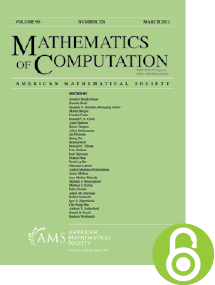Failure of the discrete maximum principle for an elliptic finite element problem
HTML articles powered by AMS MathViewer
- by Andrei Drăgănescu, Todd F. Dupont and L. Ridgway Scott PDF
- Math. Comp. 74 (2005), 1-23 Request permission
Abstract:
There has been a long-standing question of whether certain mesh restrictions are required for a maximum condition to hold for the discrete equations arising from a finite element approximation of an elliptic problem. This is related to knowing whether the discrete Green’s function is positive for triangular meshes allowing sufficiently good approximation of $H^1$ functions. We study this question for the Poisson problem in two dimensions discretized via the Galerkin method with continuous piecewise linears. We give examples which show that in general the answer is negative, and furthermore we extend the number of cases where it is known to be positive. Our techniques utilize some new results about discrete Green’s functions that are of independent interest.References
- Susanne C. Brenner and L. Ridgway Scott, The mathematical theory of finite element methods, 2nd ed., Texts in Applied Mathematics, vol. 15, Springer-Verlag, New York, 2002. MR 1894376, DOI 10.1007/978-1-4757-3658-8
- P. G. Ciarlet and P.-A. Raviart, Maximum principle and uniform convergence for the finite element method, Comput. Methods Appl. Mech. Engrg. 2 (1973), 17–31. MR 375802, DOI 10.1016/0045-7825(73)90019-4
- Michael S. Floater, One-to-one piecewise linear mappings over triangulations, Math. Comp. 72 (2003), no. 242, 685–696 (electronic).
- W. Höhn and H.-D. Mittelmann, Some remarks on the discrete maximum-principle for finite elements of higher order, Computing 27 (1981), no. 2, 145–154 (English, with German summary). MR 632125, DOI 10.1007/BF02243548
- Sergey Korotov, Michal Křížek, and Pekka Neittaanmäki, Weakened acute type condition for tetrahedral triangulations and the discrete maximum principle, Math. Comp. 70 (2001), no. 233, 107–119. MR 1803125, DOI 10.1090/S0025-5718-00-01270-9
- Kurt Kreith, Criteria for positive Green’s functions, Illinois J. Math. 12 (1968), 475–478. MR 228821
- Vitoriano Ruas Santos, On the strong maximum principle for some piecewise linear finite element approximate problems of nonpositive type, J. Fac. Sci. Univ. Tokyo Sect. IA Math. 29 (1982), no. 2, 473–491. MR 672072
- Alfred H. Schatz, A weak discrete maximum principle and stability of the finite element method in $L_{\infty }$ on plane polygonal domains. I, Math. Comp. 34 (1980), no. 149, 77–91. MR 551291, DOI 10.1090/S0025-5718-1980-0551291-3
- Ridgway Scott, Optimal $L^{\infty }$ estimates for the finite element method on irregular meshes, Math. Comp. 30 (1976), no. 136, 681–697. MR 436617, DOI 10.1090/S0025-5718-1976-0436617-2
- Gilbert Strang and George J. Fix, An analysis of the finite element method, Prentice-Hall Series in Automatic Computation, Prentice-Hall, Inc., Englewood Cliffs, N.J., 1973. MR 0443377
- Richard S. Varga, Matrix iterative analysis, Second revised and expanded edition, Springer Series in Computational Mathematics, vol. 27, Springer-Verlag, Berlin, 2000. MR 1753713, DOI 10.1007/978-3-642-05156-2
- Jinchao Xu and Ludmil Zikatanov, A monotone finite element scheme for convection-diffusion equations, Math. Comp. 68 (1999), no. 228, 1429–1446. MR 1654022, DOI 10.1090/S0025-5718-99-01148-5
Additional Information
- Andrei Drăgănescu
- Affiliation: Department of Mathematics, University of Chicago, Chicago, Illinois 60637
- Email: draga@cs.uchicago.edu
- Todd F. Dupont
- Affiliation: Department of Computer Science, University of Chicago, Chicago, Illinois 60637
- Email: t-dupont@uchicago.edu
- L. Ridgway Scott
- Affiliation: Department of Mathematics, University of Chicago, Chicago, Illinois 60637
- MR Author ID: 157720
- Email: ridg@uchicago.edu
- Received by editor(s): May 12, 2003
- Received by editor(s) in revised form: June 8, 2003
- Published electronically: March 23, 2004
- Additional Notes: The work of the authors was supported by the ASCI Flash Center at the University of Chicago under DOE contract B532820 and by the MRSEC Program of the National Science Foundation under award DMR-0213745
- © Copyright 2004 American Mathematical Society
- Journal: Math. Comp. 74 (2005), 1-23
- MSC (2000): Primary 65N30; Secondary 65N50
- DOI: https://doi.org/10.1090/S0025-5718-04-01651-5
- MathSciNet review: 2085400


